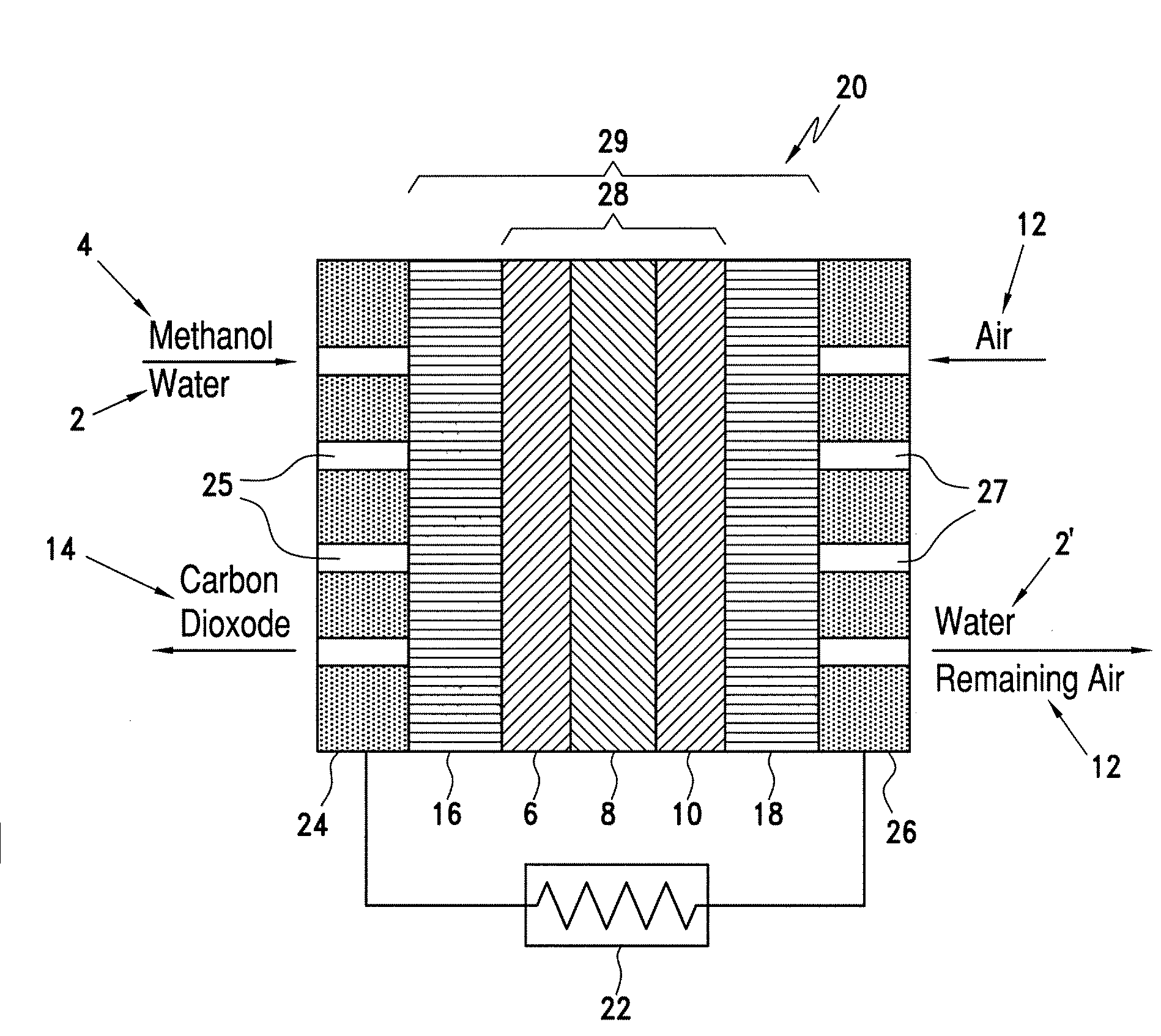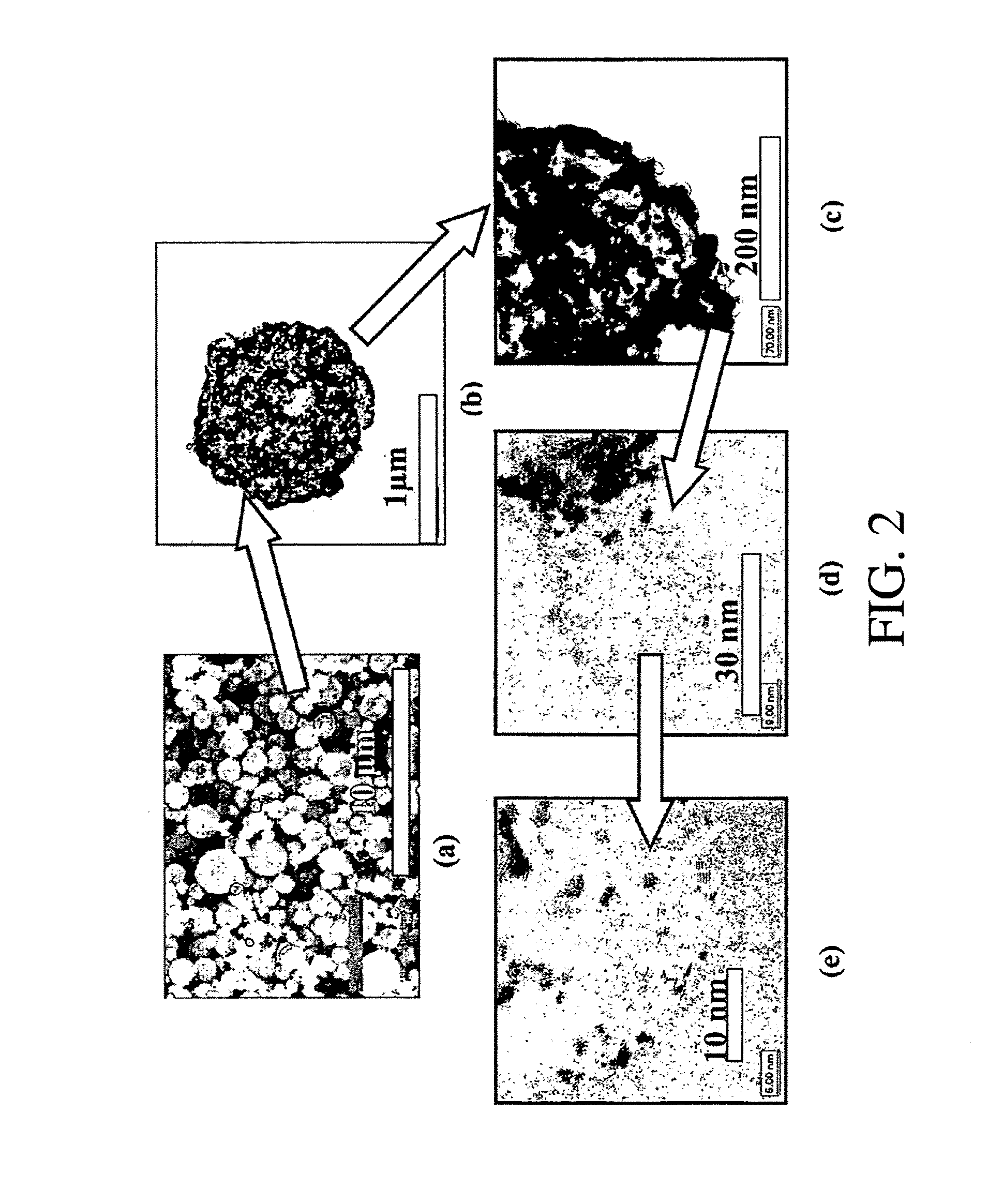Catalyst coated membranes and sprayable inks and processes for forming same
a catalyst and coating technology, applied in the field of fuel cell manufacturing, can solve the problems of difficult to employ known methods in high-volume manufacturing operations, loss of valuable catalysts, and need for relatively thick coatings
- Summary
- Abstract
- Description
- Claims
- Application Information
AI Technical Summary
Benefits of technology
Problems solved by technology
Method used
Image
Examples
example 1
Preparation of Cathode Ink using Platinum, Nominally 60% on Carbon Black of Johnson Matthey Product Number 44171
[0235]Cathode ink was prepared as follows. 6 grams of deionized water was added to 1 gm of 60-wt % platinum on carbon. 3.53 grams of 5 wt. % NAFION® perfluorinated ion exchange resin solution (vehicle: lower aliphatic alcohol / water (20%) solution (EW1100) containing 2-propanol, 1-propanol and methanol) was then added to the mixture. The resulting mixture was horn sonicated in an ice bath for 10 minutes (750W, using 20% of maximum power). The ink stability was monitored using MICROTRAC® particle size distribution measurement. The ink viscosity was monitored using the VISCOMETER®. The PSD and viscosity as a function of time are tabulated in Table 2.
example 2
Preparation of Cathode Ink using Platinum, Nominally 60% on Carbon Black of Cabot Corporation Product Number PPC965465F
[0236]A cathode ink was prepared as follows. 6 grams of deionized water was added to 1 gm of 60-wt% platinum on carbon. 3.53 grams of 5 wt. % NAFION® perfluorinated ion exchange resin solution (vehicle: lower aliphatic alcohol / water (20% ) solution (EW1100) containing 2-propanol, 1-propanol and methanol) was then added to the mixture. The resulting mixture was horn sonicated in an ice bath for 10 minutes (750W, using 20% of maximum power). The ink stability was monitored using MICROTRAC® particle size distribution measurement. The ink viscosity was monitored using the VISCOMETER®. The PSD and viscosity as a function of time are tabulated in Table 2.
example 3
Preparation of Anode Ink using Platinum, Nominally 40% and Ruthenium Nominally 20% on Carbon Black of Cabot Corporation Product Number HPR375079A
[0237]Anode ink was prepared as follows. 8 grams of deionized water was added to 1-gram platinum / ruthenium black catalyst particles. The mixture was horn sonicated in ice at duty cycle 50 amplitude 20% for 10 minutes (750W, using 20% of maximum power). 3.53 grams of 5 wt. % NAFION® perfluorinated ion exchange resin solution (vehicle: lower aliphatic alcohol / water (20% ) solution (EW 1100) containing 2-propanol, 1-propanol and methanol) was then added to the mixture. The final mixture was again horn sonicated in ice, duty cycle 50 amplitude 20% for 5 minutes (750W, using 20% of maximum power). The ink stability was monitored using MICROTRAC® particle size distribution measurement. The ink viscosity was monitored using the VISCOMETER®. The PSD and viscosity as a function of time are tabulated in Table 2.
PUM
| Property | Measurement | Unit |
|---|---|---|
| Time | aaaaa | aaaaa |
| Percent by mass | aaaaa | aaaaa |
| Percent by mass | aaaaa | aaaaa |
Abstract
Description
Claims
Application Information
 Login to View More
Login to View More - R&D
- Intellectual Property
- Life Sciences
- Materials
- Tech Scout
- Unparalleled Data Quality
- Higher Quality Content
- 60% Fewer Hallucinations
Browse by: Latest US Patents, China's latest patents, Technical Efficacy Thesaurus, Application Domain, Technology Topic, Popular Technical Reports.
© 2025 PatSnap. All rights reserved.Legal|Privacy policy|Modern Slavery Act Transparency Statement|Sitemap|About US| Contact US: help@patsnap.com



